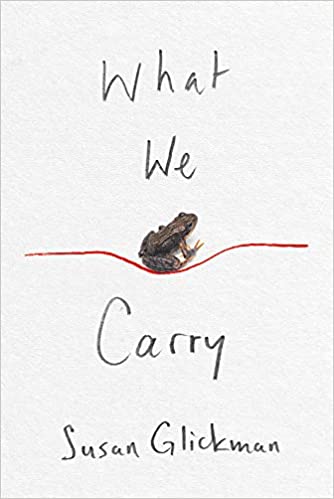
Susan Glickman. What We Carry. Signal Editions, Véhicule Press. 2019. 89pgs. $14.95.
Summarizing either the thematic concerns or the stylistic characteristics of Susan Glickman’s latest collection, What We Carry, in a sentence or two—or even a paragraph—is virtually impossible. Several of the poems respond to Chopin’s Preludes. Others riff on slang phrases. Many explore the environmental crisis that human beings can no longer deny. Despite this variety, What We Carry consists of poems that are always individually interesting and yet also comment upon each other.
The voice is both poetic and speakerly; that is, the lines are filled with images and the language is often figurative while the tone is inviting and just casual enough. This is Glickman’s seventh collection of poetry—she has also published novels and children’s books—and her experience shows.
“Ice Storm,” for instance, is among the freest of the free-verse poems—neither its lines nor its stanzas at all imitate regularity, and the voice quickly shifts from comparatively formal at the beginning to one comfortable with slang. Through its choice of imagery and metaphor, the poem becomes itself an analysis of distinctions between figurative and literal, and of the value of those distinctions. The speaker consistently second-guesses her statements, correcting herself or at least refining her interpretations. Here is the first stanza:
Everything’s exquisite
albeit decorative and dead
as a Fabergé egg.
I put on my old-lady shoes
and heel-toe it down the street.
Over the pavement there is ice,
over the ice, slush,
over the slush a layer of snow
and sleety particulate
so that it is curiously like walking across sand
except not at the beach
and not in summer
where, after all, there would be
some vital signs.
Words like “exquisite,” “albeit,” even “Fabergé” suggest an educated and perhaps detached speaker, one who might not wear, or admit wearing, “old-lady shoes,” one who might not be playful enough to “heel-toe it.” Ironically, the most definite sonic device occurs in the opening more formal lines, the alliteration of “decorative and dead,” itself also an ironic commentary on beauty. Softer alliteration occurs a few lines later with “slush…slush…snow…sleety,” enhanced with the sibilants in “ice…ice” and “curiously.” The only simile occurs right then, “like walking across sand,” which the speaker immediately undercuts by discussing how the simile is inaccurate.
The second stanza begins by stating, “Ice does a plausible imitation of life,” and then continues with descriptions of ice in the mundane form of ice cubes rather than the “exquisite” meteorological ice from stanza one. This second stanza concludes with an associative memory of the speaker’s grandfather, permitting the third stanza to open with phrase containing such a common metaphor that we often forget its metaphoric status: “’On the rocks,’ he called it, / which baffled me as a child.” Many readers will recall that childhood bafflement on first hearing idiomatic or figurative language. Even here, the speaker revises her description, and the revision helps her convey her experience more accurately:
I was slow that way,
holding out for a version of the universe
where each thing was one thing only.
Itself.
Or not slow, exactly, more like credulous
because I already knew better; knew
that the world I lived in
and the one I was told about
were not the same.
And so here she is, telling about the world herself, using language so infused with metaphor that one thing can never be “one thing only.” One thing can never be simply “Itself,” no matter how much we desire it to be, for each thing is interpreted as it is perceived—or if a thing can be exclusively “Itself,” it can never be that same “Itself” to anything else. As much as we require language to make sense of the world, language also inevitably filters our understanding. Even the ending of this poem, for all of its critique of language, is ambiguous—is the tone matter-of-fact, mournful, or more sinister? I interpret it as sad, especially given the content of much of the rest of the collection, but in a different context, it could easily be read differently.
“At Drake Bay” begins as a simple—attractive but still apparently simple—description of fish near shore, but it becomes, at its conclusion, a summary of the collection’s primary theme. The speaker watches as
blue damselfish flickered
amidst the wavering angels,
lavender puffers lurked under lava rock,
and between trees of white coral
darted silver needles.
Again, here, the most common sonic elements are alliteration and assonance. Glickman seems attentive to sound without being obsessed with it—the sounds are attractive, but they don’t overwhelm the ear.
In its final stanza, the poem becomes much more thematically explicit:
At night millions of stars
watched, or didn’t,
from an impenetrable sky.
One definition of grace: nature
without us.
Despite its brevity, this stanza accomplishes a lot. The first lines call attention to human solipsism, with our frequent temptation to assume that all of creation attends to us. The fourth line of this stanza exploits enjambment, a tactic Glickman seldom takes, and so it stands out particularly strongly. The line seems logical, even reassuring, almost Romantic: “One definition of grace: nature.” But the sentence doesn’t end there: “nature / without us.” As much of the rest of the book demonstrates through its exploration of extinction and other environmental disasters, we have chosen instead to be us without nature.
Glickman uses her straightforward diction to her advantage throughout the collection. It permits her to call attention to environmental collapse without sounding accusatory or self-righteous. She leaves readers to examine their own consciences. There’s a lot more to discuss in What We Carry—Glickman’s explorations of art and beauty and everyday life, her finesse with form, her ability to connect the one to the many—but rather than risk that her poetry will be lost in the analysis as it so often is in the translation, I’ll simply encourage readers to pick up this collection, then to explore her earlier work, and then to hope for
